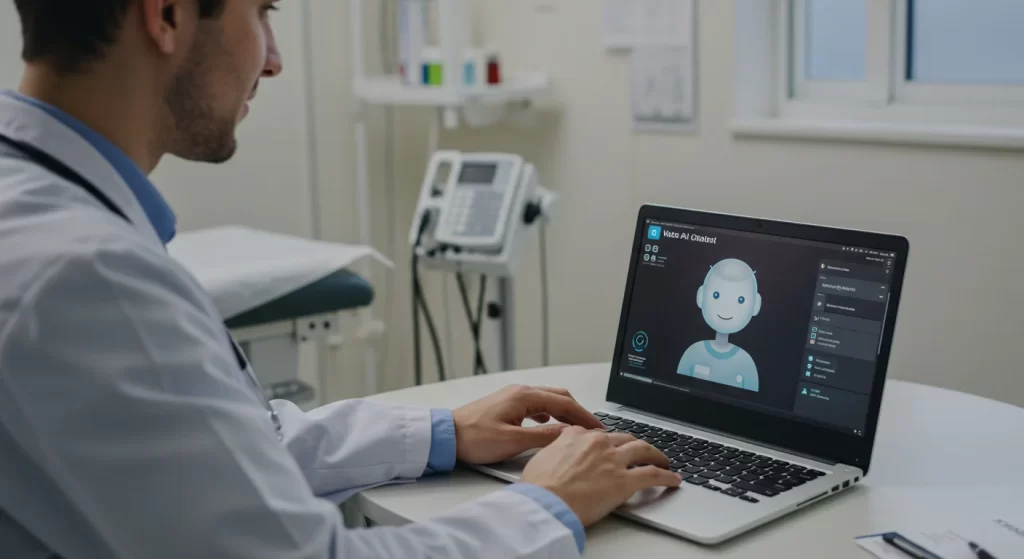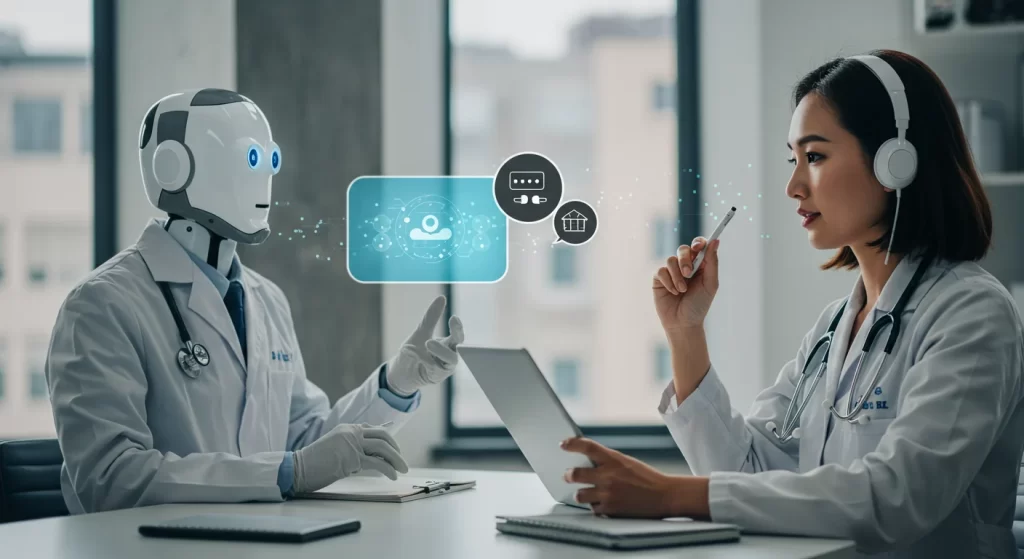Imagine a healthcare system where physician burnout is significantly reduced, patient interactions are more meaningful, and administrative tasks that once consumed hours are completed in minutes. This isn’t a distant dream; it’s the rapidly unfolding reality powered by voice AI healthcare. Voice AI healthcare is no longer a niche technology but a transformative force, rapidly gaining traction across the healthcare landscape. Its adoption is accelerating, driven by the urgent need for greater efficiency, improved patient experiences, and better support for overburdened healthcare professionals.

The global voice tech in healthcare market underscores this momentum, valued at almost $4.3 billion in 2023 and projected to soar to over $21 billion by 2032. This significant financial investment and robust growth trajectory signal more than just incremental improvements; they point towards a fundamental shift in how healthcare services are conceptualized and delivered. Voice AI in healthcare is becoming integral to the care process itself.
Interestingly, while automation is a key driver, a significant factor propelling voice AI healthcare adoption, particularly in patient-facing roles, is its ability to offer a more “human-like” and empathetic interaction compared to older automated systems. Patients often seek a human connection, especially when dealing with stressful health-related inquiries, and voice AI in healthcare technologies are being designed to convey empathy through tone modulation and natural conversational flow. This addresses a critical failure point of previous automation attempts, which often fell short not just in capability but also in user experience.
This article will dive into the multifaceted world of voice AI healthcare, exploring its core technologies, profound benefits, diverse applications, critical challenges, and the exciting future it promises for a more efficient, accessible, and patient-centric healthcare ecosystem.
Ready to explore how voice AI solutions can transform your medical organization? Discover our expertise in creating and integrating cutting-edge AI voice agents!
Understanding Voice AI in Healthcare: More Than Just Talk
Voice AI in healthcare refers to the application of AI techs that enable machines to understand, process, and respond to human speech for a wide array of healthcare-related tasks. It transcends simple voice-to-text transcription; it involves a sophisticated understanding of intent, medical context, and even nuanced communication. This capability allows healthcare voice AI to move beyond basic dictation to become an intelligent interactive partner.
Core Technologies Powering the Voice Revolution
The power of voice AI healthcare stems from a combination of advanced technologies working in concert. This “intelligence stack” is what truly differentiates sophisticated voice AI in healthcare from simpler voice-enabled tools:
- Speech Recognition (ASR). This is the foundational technology that converts spoken audio into machine-readable text. In the healthcare domain, modern ASR systems are meticulously trained on vast datasets of medical language, encompassing complex terminology, diverse accents, and challenging acoustic environments.
- Natural Language Processing (NLP) / Natural Language Understanding (NLU). Once speech is converted to text, NLP and NLU enable the AI to comprehend the meaning, intent, and even sentiment behind the words. These technologies allow systems to understand medical jargon within context, interpret nuanced patient queries, and engage in more natural, free-flowing dialogues.
- Machine Learning (ML) and Neural Networks. These subfields of AI empower voice systems to learn from the vast amounts of data they process. Through continuous learning, voice AI healthcare applications improve their accuracy in speech recognition, deepen their understanding of language, and refine their responsiveness over time.
The effectiveness of voice AI in healthcare is directly proportional to the sophistication and seamless integration of these layers, especially when dealing with the complexities of medical language and the critical nature of patient interactions.
Voice AI vs. Traditional IVR and Basic Speech-to-Text
The advancements inherent in voice AI healthcare set it markedly apart from older technologies like traditional Interactive Voice Response (IVR) systems and basic speech-to-text tools. While IVRs are often reactive, waiting for specific button presses or simple commands, advanced healthcare voice AI is moving towards more proactive and even predictive engagement, driven by its learning capabilities. The shift from rigid IVR menus to natural language interaction also democratizes access to information and services for patients who may struggle with complex phone trees or digital interfaces.
The following table provides a comparative analysis:
| Feature | Voice AI | Traditional IVR |
|---|---|---|
| Conversational Ability | Human-like, free-flowing dialogue; understands natural language and intent. | Rigid, menu-driven interactions; limited command recognition. |
| Intelligence & Context | Leverages NLU/LLMs for deep understanding, context awareness across conversational turns, and logical application. | Lacks deep understanding and real-time interpretation; relies on pre-set rules. |
| Real-time Integration | Can integrate with live data (e.g., EHRs, scheduling systems) for dynamic actions like real-time appointment booking. | Typically lacks real-time integration with dynamic backend systems. |
| Adaptability & Learning | Continuously learns and improves from interactions; adapts to new terms and user behaviors. | Rule-based and static; does not typically learn or adapt. |
| Specialty-Specific Logic | Can be configured with specific workflows and knowledge for different medical specialties. | Generally offers generic, one-size-fits-all menu structures. |
| Patient Experience | More intuitive, less frustrating, often perceived as empathetic and efficient. | Often frustrating, impersonal, and can lead to longer call times. |
| Operational Flexibility | Highly adaptable to evolving healthcare needs and complex workflows. | Inflexible call flows that struggle with evolving needs. |
This comparison underscores why voice AI healthcare represents a significant upgrade over traditional systems, offering tangible advantages in patient experience, operational efficiency, and intelligent interaction.
The Multifaceted Benefits of Voice AI Healthcare
The adoption of voice AI in healthcare is driven by a compelling array of benefits that span patient care, clinician well-being, and organizational efficiency. These advantages are often interconnected, creating a virtuous cycle.

Enhancing Patient Outcomes and Experience
Voice AI healthcare significantly enhances clinical documentation by enabling more precise, complete, and timely notes. Studies show dictated notes contain fewer errors, and AI transcription can reduce documentation errors substantially. This accuracy is vital for decision-making and patient safety. One of the most valued benefits is increased patient-clinician face time. By automating documentation, Healthcare voice AI allows clinicians more quality time for direct interaction, as speech is faster than typing.
Furthermore, AI voice agents for healthcare improve patient engagement and accessibility by offering 24/7 support for scheduling and FAQs. The intuitive nature of voice makes services accessible to diverse populations, including the elderly and those with disabilities. Advanced systems also offer personalized interactions by learning from individual patient data.
Reducing Clinician Burnout and Improving Workflow Efficiency
The administrative workload is a primary driver of clinician burnout. Voice AI healthcare directly addresses this by automating tasks like note-taking and scheduling, with some systems reporting significant improvements in provider productivity and hours saved. Voice dictation is inherently faster than typing, leading to substantial efficiency gains. By alleviating tedious tasks, Healthcare voice AI positively impacts provider well-being and job satisfaction.
Driving Operational and Financial Gains for Healthcare Organizations
Implementing voice AI healthcare can dramatically reduce traditional medical transcription costs. Enhanced documentation accuracy translates to more precise medical coding, minimizing claim rejections and improving revenue cycle management. Efficiencies in scheduling and faster patient turnarounds, enabled by healthcare voice AI, can increase patient capacity and revenue. Overall, streamlined workflows contribute to broader operational cost savings.
These benefits align with value-based care models, positioning voice AI healthcare as a strategic technology. Richer data captured by voice AI in healthcare can fuel advanced analytics for proactive and preventative care, potentially leading to significant long-term cost savings by preventing expensive acute care episodes.
Key Applications of Voice AI Transforming Care Delivery
Voice AI healthcare is rapidly becoming a practical tool across the healthcare spectrum. The trend is evolving from automating discrete tasks to orchestrating entire patient journeys. Every voice interaction generates valuable data for training more advanced AI models. The “ambient” experience, prominent in documentation, is also poised to expand.

Patient-Facing Innovations
Voice AI in healthcare is revolutionizing patient interactions.
1. Streamlining Access. Appointment scheduling, patient Intake, and triage AI voice agents for healthcare transform appointment scheduling with 24/7 automated booking, rescheduling, and cancellations, reducing wait times and no-shows. For patient intake, voice AI healthcare conversationally collects information and medical history before consultations, reducing paperwork. In triage, healthcare voice AI performs initial symptom checks to determine the appropriate care level, potentially reducing unnecessary emergency visits.
2. Enhancing Support. FAQ answering, prescription refills, and billing inquiries AI voice agents for healthcare provide instant answers to FAQs, freeing staff. Prescription refills become more convenient with voice AI healthcare, integrating with EHRs and pharmacy workflows. For billing inquiries, voice AI in healthcare handles sensitive conversations with empathy, explaining charges and resolving queries.
3. Remote Care and Monitoring. Telehealth, post-discharge follow-up, chronic disease management healthcare voice AI enhances telemedicine by assisting with virtual appointment setup and preliminary information collection. Automated post-discharge follow-up calls using Voice AI healthcare monitor recovery and identify complications, helping reduce readmissions. For chronic disease management, voice AI in healthcare conducts daily check-ins, monitors symptoms, and offers personalized advice.
4. Mental Health Support. Voice AI healthcare offers accessible mental health support through mood check-ins, CBT-based exercises, and coping strategies.
Clinician-Facing Solutions
Healthcare voice AI also supports clinicians directly.
1. Revolutionizing Clinical Documentation (Ambient Scribes, Dictation). Medical voice recognition software allows clinicians to dictate patient notes directly into EHRs, a method significantly faster and often more accurate than typing. Ambient AI scribes listen to patient-clinician conversations and automatically generate structured clinical notes, aiming to make documentation almost invisible.
2. Assisting in Consultations and Decision Support. During consultations, clinicians can use voice commands to quickly retrieve patient information from EHRs or access medical research. Voice AI in healthcare can provide real-time translation services. While not replacing clinicians, Healthcare voice AI can assist in diagnosis by analyzing symptoms and suggesting potential diagnoses.
Table. Overview of Voice AI Applications in Healthcare and Their Core Benefits
| Application Area | Specific Use Cases | Key Voice AI Functionality | Primary Benefits (Patient & Clinician / Organizational) |
|---|---|---|---|
| Patient Access & Scheduling | Appointment booking, rescheduling, reminders, patient intake | NLU, ASR, real-time calendar integration, automated outreach | Reduced wait times, lower no-show rates, 24/7 access, decreased staff workload |
| Clinical Documentation | Medical dictation, ambient note generation | ASR, NLP (medical), EHR integration | Increased accuracy, significant time savings for clinicians, reduced burnout, improved note quality |
| Patient Support & Communication | FAQ answering, billing inquiries, prescription refills | NLU, ASR, knowledge base integration, empathetic response generation | Immediate support, improved patient satisfaction, efficient query resolution, better medication adherence |
| Remote Care & Monitoring | Telehealth assistance, post-discharge follow-up, chronic disease management | Conversational AI, symptom tracking, personalized reminders, data collection | Enhanced continuity of care, reduced readmissions, improved management of chronic conditions, greater patient engagement |
| Mental Health Support | Mood check-ins, CBT exercises, crisis resource connection | Empathetic AI, NLP for sentiment analysis, structured interaction delivery | Increased accessibility to mental health resources, anonymous support, continuous engagement |
| Clinical Decision Support (Assistive) | Information retrieval during consults, translation, diagnostic suggestions | Voice commands for data access, real-time translation, pattern recognition from symptoms | Faster access to information for clinicians, improved communication with diverse patients, support for diagnostic process |
This table offers a snapshot of how voice AI healthcare is being deployed.
Navigating the Path to Adoption: Challenges and Considerations
Successful voice AI healthcare adoption requires navigating technical, security, ethical, and practical challenges. A “trust deficit” is a significant barrier; patients express privacy concerns, and clinicians require reliability assurances. These challenges are often intertwined, demanding a holistic approach. The evolving regulatory landscape, including HIPAA and emerging AI-specific regulations, presents both hurdles and catalysts for responsible innovation. Given that AI errors are inevitable, robust error management and “human-in-the-loop” protocols are essential safety nets.
Technical Hurdles
Consistent accuracy and reliability of voice AI healthcare systems are primary concerns. They must understand diverse accents, complex medical jargon, and operate in noisy environments. Seamless integration with existing systems like EHRs (e.g., Epic, Cerner), scheduling platforms, and billing systems is complex but vital. Scalability and performance without degradation are also crucial, especially for real-time applications.
Data Privacy and Security
Voice interactions in voice AI healthcare involve Protected Health Information (PHI), making HIPAA compliance non-negotiable.
Table. Key HIPAA Compliance Best Practices for Voice AI in Healthcare
| Compliance Area | Best Practice Description |
|---|---|
| Data Encryption | PHI must be encrypted both in transit and at rest using strong encryption protocols. |
| Access Controls & Authentication | Implement strict authentication (e.g., multi-factor authentication) and role-based access controls. |
| Business Associate Agreements (BAAs) | Execute BAAs with any third-party voice AI vendors handling PHI. |
| Patient Consent & Authorization | Obtain appropriate patient consent for recording and authorization for PHI uses/disclosures beyond treatment, payment, or healthcare operations. |
| Audit Trails & Monitoring | Maintain comprehensive audit logs and regularly monitor for suspicious activity. |
| Data Minimization & De-identification | Collect only necessary PHI; use de-identified data for AI model training where feasible. |
| Staff Training | Provide thorough training on HIPAA, data privacy, and secure use of voice AI tools. |
| Transparency with Patients | Clearly inform patients about voice data collection, use, storage, and protection. |
Ethical Imperatives
Using AI in healthcare carries significant ethical responsibilities. Voice AI healthcare systems can perpetuate biases if trained on unrepresentative data, leading to care disparities. Transparency in AI model training and decision-making is crucial. Establishing clear accountability for AI performance and error management is also vital.
Patient Safety
Voice AI healthcare systems, especially LLMs, can produce false or inaccurate information (“hallucinations”), posing risks to patient safety. Healthcare organizations must develop robust protocols for managing AI errors, including immediate correction, patient communication, incident reporting, and clinician override. Human oversight is critical; AI should augment, not replace, clinician expertise.
Data Governance and Policies for Voice Recordings as Medical Records
Clear institutional policies are needed to define if and how voice recordings become part of the official patient medical record. Policies must address patient consent for recording, especially in sensitive scenarios, aligning with HIPAA and other laws. Guidelines for recording devices in clinical settings are also necessary to protect patient privacy.
Finally, overcoming skepticism and ensuring patient and staff comfort with voice AI healthcare tools is a hurdle. Privacy concerns are prevalent. Meanwhile, adequate training for staff and patients is essential for effective use.
Trends and Market Outlook for Voice AI in Healthcare
The trajectory of voice AI healthcare is one of rapid evolution. Market indicators show strong growth, and emerging voice AI healthcare trends 2025 promise even more sophisticated solutions. The convergence with IoT, wearables, and Generative AI suggests voice as a primary interface to a comprehensive AI ecosystem. The role of voice AI in healthcare is maturing from reactive problem-solving to enabling proactive health management. The ROI narrative is shifting from efficiency gains to a broader value proposition including improved patient outcomes, aligning with value-based care.
Market Growth, Statistics, and Projections
The global voice technology and AI in the healthcare market is experiencing significant growth. In 2023, it was valued at approximately USD 4.3 billion. Projections indicate expansion to USD 21.4 – 21.67 billion by 2032, with a robust CAGR of 19.5% – 19.9%. Some analyses suggest an even higher CAGR for the voice AI healthcare market specifically. Broader AI in healthcare market statistics also reflect this dynamism. Key drivers include improved clinical efficiency, EHR integration, reducing physician burnout, and telehealth growth. North America currently leads, with Asia Pacific rapidly emerging. These healthcare voice AI trends 2025 are notable.
Table. Voice AI in Healthcare Market Snapshot
| Metric | Value / Description | Key Market Segments | Leading Region |
|---|---|---|---|
| Global Market Size 2023 | ~ USD 4.3 Billion | Application: Patient-Provider Communication (Dominant), Vocal Biomarkers (Highest Growth) | North America |
| Projected Market Size 2032 | ~ USD 21.4 – 21.67 Billion | End-User: Physicians (Dominant), Patients (Fastest Growing) | |
| CAGR (2024-2032) | 19.5% – 19.9% | ||
| Key Drivers | Improved clinical efficiency, EHR integration, physician burnout reduction, telehealth growth |
Emerging Trends Shaping the Future (2025 and beyond)
The evolution of voice AI healthcare is marked by several key trends for 2025. These include enhanced NLP and Conversational AI for more accurate, context-aware, and nuanced voice interactions, with a deeper understanding of medical terminology and emotional tone.
Another significant trend is the move towards more personalized patient interactions and proactive care, leveraging individual patient data and predictive analytics to identify health risks earlier. Deep integration with IoT devices, wearable sensors, and ambient environmental sensors will create a more connected health ecosystem, facilitating real-time data collection and continuous remote patient monitoring. The rise of GenAI is set to significantly boost Healthcare voice AI capabilities, making AI voice agents for healthcare more adept at generating clinical summaries, drafting patient communications, and engaging in complex conversations.
Furthermore, the expansion of vocal biomarkers — analyzing voice patterns to detect early signs of diseases like Parkinson’s, Alzheimer’s, respiratory illnesses, and mental health conditions — is a rapidly advancing field with high growth potential, a key healthcare voice AI trend 2025. Finally, there’s an increased focus on developing emotionally aware AI that can detect and respond appropriately to emotional cues in a patient’s voice, which will be particularly beneficial in mental health support and chronic disease management.
Conclusion
Voice AI healthcare is undeniably reshaping the healthcare landscape, moving from a futuristic concept to a practical and impactful technology. Its ability to understand and process human speech is unlocking new levels of efficiency, enhancing patient experiences, and providing much-needed support to clinicians burdened by administrative tasks. From streamlining appointment scheduling and clinical documentation with ambient scribes to enabling more empathetic patient interactions for billing inquiries and supporting remote patient monitoring, the applications are diverse and growing.
The benefits are multifaceted: patients gain more accessible and responsive care, clinicians find relief from administrative overload and can dedicate more time to direct patient interaction, and healthcare organizations achieve significant operational and financial gains. Market trends, including voice AI healthcare trends 2025 and healthcare voice AI trends 2025, show a strong and accelerating adoption curve.
However, the path to widespread adoption is not without its challenges. Technical hurdles related to accuracy and seamless integration with complex existing systems like EHRs must be continually addressed. Paramount among these considerations are data privacy and security; ensuring HIPAA compliance for voice AI in healthcare is non-negotiable. Ethical imperatives, including mitigating algorithmic bias and ensuring transparency, must guide development. Furthermore, patient safety remains the utmost priority, necessitating rigorous error management protocols and the steadfast role of human oversight.
The future of voice AI healthcare is bright. Emerging trends like enhanced NLP, deeper IoT integration, the rise of Generative AI in voice applications, the expansion of vocal biomarkers, and more emotionally aware AI promise even more sophisticated solutions. Healthcare leaders are encouraged to proactively explore and strategically implement voice AI healthcare. By doing so, they can unlock its full potential, fostering a future where tech and the human touch work in concert to create a more efficient, accessible, and more human-centered system of care.
Transform patient engagement and clinical efficiency with intuitive voice AI. SPsoft specializes in developing and seamlessly integrating custom voice AI solutions!
FAQ
What exactly is Voice AI in healthcare?
Voice AI in healthcare refers to the use of artificial intelligence technologies, including speech recognition, natural language processing (NLP), and machine learning (ML), to enable computers and devices to understand, process, and respond to human speech for various healthcare-related tasks. It aims to create human-like conversational experiences to assist patients and clinicians.
How is Voice AI different from the IVR systems I’m used to?
Voice AI healthcare offers a significantly more advanced and natural interaction compared to traditional Interactive Voice Response (IVR) systems. While IVRs typically rely on rigid, pre-programmed menu options and limited keyword recognition, Healthcare voice AI uses NLP and ML to understand free-flowing, natural language, interpret user intent and context, and engage in dynamic, intelligent conversations. Voice AI in healthcare can also integrate with real-time data and adapt its responses, whereas IVRs are generally static and rule-based.
What are the main benefits of using Voice AI for patients?
Patients benefit from improved access to care through 24/7 automated services like appointment scheduling and FAQ answering. They experience reduced wait times, more convenient prescription refill processes, and potentially more empathetic interactions for sensitive topics like billing. Voice AI in healthcare also enhances patient engagement through reminders, educational content, and support for remote care and chronic disease management.
How does Voice AI help reduce doctor and nurse burnout?
A primary benefit of voice AI healthcare is its ability to significantly reduce the administrative burden on clinicians, a major contributor to burnout. It automates time-consuming tasks like clinical documentation (through dictation and ambient scribing), scheduling, and responding to routine inquiries. This allows doctors and nurses to spend less time on paperwork and more time focusing on direct patient care, leading to improved workflow efficiency and job satisfaction.
Is Voice AI secure for handling sensitive patient information?
Yes, reputable healthcare voice AI solutions designed for healthcare prioritize security and HIPAA compliance. This is achieved through measures such as end-to-end encryption of voice data, strict access controls, comprehensive audit trails, and Business Associate Agreements (BAAs). Continuous monitoring and adherence to data privacy best practices are essential.
Can Voice AI understand complex medical terms and different accents?
Advanced voice AI in healthcare systems are specifically trained on extensive medical datasets, including complex terminology, and are designed to recognize a wide range of accents and dialects. Through machine learning, these systems continuously improve their accuracy in understanding and transcribing medical language.
What happens if the Voice AI makes a mistake or doesn’t understand me?
Well-designed AI voice agents for healthcare incorporate error handling and escalation protocols. If the AI cannot understand a query, detects urgency, or if the query is outside its capabilities, it should smoothly transfer the interaction to a human agent. In clinical settings, human oversight is crucial to validate AI-generated information.
How is Voice AI being used in telemedicine and remote patient monitoring?
In telemedicine, Voice AI healthcare can assist with virtual appointments and information collection. For remote patient monitoring, it enables automated check-ins, symptom reporting, medication reminders, and can alert providers to potential issues, especially for chronic disease management.
What is the future of Voice AI in healthcare?
The future, guided by voice AI healthcare trends 2025 and healthcare voice AI trends 2025, points towards more sophisticated Voice AI healthcare with enhanced natural language understanding, greater personalization, and deeper integration with IoT devices. Expect expanded use of Generative AI, growth in vocal biomarkers for early disease detection, and more emotionally aware AI.
How can my healthcare organization get started with Voice AI?
Begin with a needs assessment to identify high-benefit use cases for voice AI healthcare. Choose a reputable vendor with healthcare experience. Plan for integration with systems like EHRs, ensure robust security and HIPAA compliance, and develop a strategy for staff and patient training. A pilot program is often advisable.



